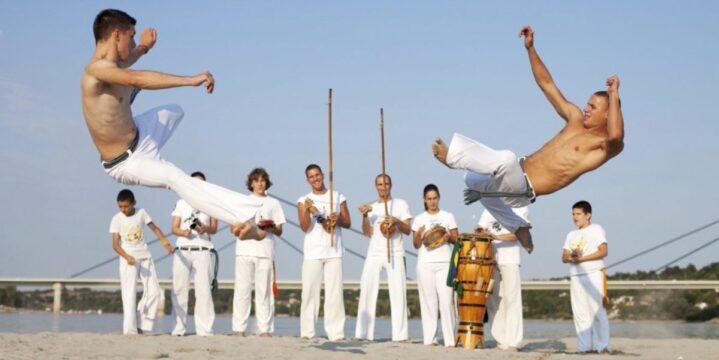
Capoeira in my life
Capoeira is an expression that mixes Afro and Brazilian cultures. It works in different instances of art and body, such as music, dance and sport. Despite the fact that it doesn’t have a single concept. It could be considered a sport, a fight or a cultural manifestation. However, the benefits that the practice has for health are clear, such as reducing stress and weight, controlling blood pressure and improving the cardiovascular system. Depending as Capoeira is shown, it can have the vision of sport or philosophical question.
Being an apprentice of Capoeira for 16 years now, when it was introduced me by great Mestre* named Joaozinho da Figueira* In Brazil, I am passionate about the results and pleasure that Capoeira gives me in my life. I practice Capoeira in happy moments and also in not so happy moments of my life. I will explain this ambiguity. I have psychologically assimilated Capoeira in my life as a way of expression, instead of sport. When I play in the low moments, I let all sad feelings be released from my mind although it means fight and force. Whilst in the happy moments, I am play, it works like celebration and achievements of my life.
Capoeira is strongly driven by the rhythm of the music which is extremely important to dictate the pace of the fight and even determine some of the blows that can be taken. In addition, music is an important cultural component, as it tells about the past and history. Capoeira is a very special feeling to me!
The body connects with the mind, and the result could not be better, an amazing synchronisation force, ginga* and defence. It uses all parts of the body, and allows it to function on the ground or through the air with kicks.
There are two main types of Capoeira: Angola and Regional. Regional Capoeira, incorporates elements from other martial fights, creating a sequence of strokes and a teaching methodology. It also features faster movements and has a uniform that consists of white trousers and a white top. Angolan Capoeira, on the other hand, was created as a reaction of some Mestres* of Capoeira, especially. This type of Capoeira is considered to be the traditional one, with slower movements and is not interpreted as a sport, but as a cultural manifestation. Angolan Capoeira does not have a uniform. Regional Capoeira, on the other hand, does.
Identifying the exact origins of Capoeira is extremely difficult, as there are no written documents about it. So far, what is known is that it did not have a single place of origin, as it appeared in many places in Brazil where black Africans settled. In each location it acquired distinct characteristics, some of which became better known and became references. One of the most influential African manifestations for the emergence of Capoeira is N’golo, which exists in Southern Angola.
Capoeira was a weapon that blacks exposed when they had no other alternatives. They used it either to defend the quilombo* or to escape slavery. Thus, it appeared in a contest of clashes and meant the challenge to the slave system.
The risks when practicing are low, as there is not much direct contact between the people participating in the roda*, that is, the kicks and other blows do not reach the opponent.

Capoeira benefits
1. It contributes to weight loss: Capoeira is an aerobic activity and therefore helps in burning calories. One hour can burn about 700 calories.
2. Reduces stress: Capoeira has music, fighting and aerobic activity. This combination is perfect for reducing stress. The person transfers stress to the moment of the fight, the music helps to relax and the aerobic activities release endorphins that provide the feeling of wellbeing.
3. Improves the cardiovascular system: The practice, as well as other aerobic exercises, makes the heart work more efficiently without having to make great efforts. Blood flows better; arteries and vessels are healthier. All of this prevents the risk of cardiovascular diseases, such as heart attacks, high cholesterol, stroke and hypertension.
4. Improves flexibility: Capoeira involves kicks, jumps and other movements that contribute greatly to improving flexibility.
5. Stimulating popular culture: As mentioned before, Capoeira is not just a fight, it is also a cultural manifestation. For this reason, when practicing Capoeira one also learns about the history and culture of Brazil, especially Afro-Brazilian.
*ginga: the most basic movement of Capoeira, aimed at placing the right hand forward and the right leg backwards (and redo the process with the left side). It is from this movement that other blows take place.
*quilombo: secret place where the escaped slaves stayed or went, usually covered or hidden in the woods
*roda: a circle formed by people (in most cases Capoeiristas) singing and clapping with hands under the sound of Capoeira music.
*Mestre : person considered master because has graduation archived for a lifetime dedicated to Capoeira
*Mestres: plural of Mestre
*Joaozinho da Figueira: he was my first Mestre of Capoeira. He is the founder of Capoeira Mar Azul. More information: https://www.marazul.co.uk



